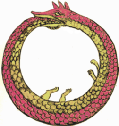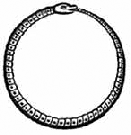The Ouroboros in Eastern mythology is a snake eating it’s own tail, symbolizing the cyclic nature of things and immortality.
In old Europe, the snake represented the power in the earth that supports life and the transformation of life on its surface. The snake was recognized as the actual force behind nature. (An encyclopedia of archetypal symbolism)
In “The Goddesses and Gods of old Europe”, Marija Gimbutas writes, “…The Neolithic agriculturists… mythologized the snake, attributing a power that can move the entire cosmos. Compositions on the shoulders of cult vases reveal pairs of snakes with opposed heads, “making the world roll” with the energy of their spiraling bodies.”
In Geoffrey Ashe’s “The Ancient Wisdom” … “Everywhere the snake or the spiral appears in the presence of new life: vases flaunt a gigantic snake winding over the whole universe, or over the sun, moon, and stars; elsewhere the snake appears below a growing plant or coils above the belly of a pregnant woman…The snake was a symbol of energy – spontaneous, creative energy – and of immortality.”
Again from “An encyclopedia of Archetypal Symbolism”, …in later ages, especially among Semitic and Indo-European peoples, the dragon (Gk. Drakon – serpent) or cosmic serpent is seen as a symbol of the chaos that must be overcome in order for life to be maintained in a meaningful way. In Hebrew texts (e.g., Isaiah 27:1 and Job 7:12) as well as in the apocalyptic literature of Christianity (e.g., Revelations 12-13, 20), the primeval dragon is said to have been defeated, but not totally eliminated, and it will return during the last days to wreak havoc before finally being destroyed.
In Norse mythology, Jormungand was a cosmic serpent representing evil and destruction; biting it’s own tail it encircled the whole world, holding it at it’s mercy.
The story of St. George and the dragon in an infamous painting by Paulo Ucello depicts a surreal scene in which a dragon is chained on a leash delicately held by a maiden, whilst a mounted knight pierces the dragon’s eye with his long lance. The dragon’s coiled tail spirals away into the distance, whilst another spiral formed in light clouds dominates the sky. This, to me (and others), is an allegory which can be compared to a dimensional world above and below ours. The passive role of the maiden is in contrast to the dynamic heroism of the knight, but between them the dragon is defeated.
Our ever evolving mind-set
Notice how the original significance of the snake as creative force has more recently become the symbol of a destructive force! If we take any pair of opposites, for example, love and hate, in effect they are extremes of one uniting force, in this case emotion. For one to exist there has to be the other! Examples include Yin and Yang as a pair of opposites united within Chi; in physics as positive, negative and neutral. The list is endless.
I wonder if this mind-set (like a 3 dimensional reality) has anything to do with our 3 dimensional perception of space? Will we automatically perceive things more objectively if we make a dimensional leap in consciousness? A higher mind-set where there are no conflicting ideas or emotions, as we will naturally understand things more objectively? Perhaps Pagans perceived a 2 dimensional reality and cavemen a one dimensional reality. Cavemen’s paintings were often simple, but well executed line drawings or stencils. Even the relatively advanced Egyptians had major problems with spatial perspective and literally ignored the 3 rd dimension in their artwork! It wasn’t until the 15th century when Paolo Ucello first used perspective in painting. This breakthrough might also have been discovered independently by Alberti in 1435 with his perspective rules as people often share the same ideas simultaneously, without the need of direct communication! But more on this later.
Circles, cycles and Spirals.
An interesting scientific breakthrough caught my attention in the 1980’s. A biologist was studying a group of small aquatic organisms called Oxyrris. These creatures have a whip like tail (flagellum) that they use for propulsion. At this time it was assumed that the motion of these flagella was like a snake,

OUROBOROS
VARIATIONS
VARIATIONS
